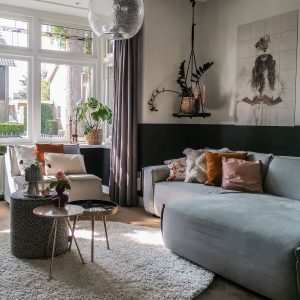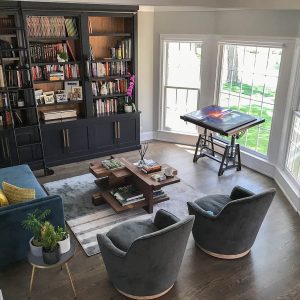‘How to Choose the Right Color Palette for Your Eclectic Home‘ starts with grasping your space’s unique character and exploring how colors can amplify its eclectic charm.
Creating an eclectic home is an adventure in design, blending various periods, styles, textures, and yes—colors.
But amidst this exciting mix, how do you ensure that your color choices enhance rather than clash?
This blog post dives into the art of selecting the perfect color palette for your eclectic home, ensuring a cohesive yet diverse atmosphere.
How to Choose the Right Color Palette for Your Eclectic Home
Ready to embark on this colorful journey?
Let’s get started.
Eclectic Style 101: Defining Your Unique Home Aesthetic
What Defines an Eclectic Home?
An eclectic home celebrates the harmonious fusion of disparate elements. It’s where antique meets modern, and bold patterns live alongside subtle hues.
But what ties these elements together?
More often than not, it’s a well-thought-out color palette.
Understanding the eclectic style is your first step towards creating a space that feels both unified and uniquely yours.
The Significance of Color in Eclectic Decor
Color not only affects the mood of your space but also unites diverse decor elements. Choosing the right colors can make your eclectic mix look intentional, not chaotic.
But how do you start?
And what should you consider?
Let’s delve into the basics of color theory to answer these questions.
Color Theory Essentials for Eclectic Home Decor
Navigating the Color Wheel
At the heart of any design, whether it’s fashion, art, or interior decor, lies the color wheel. This circular diagram of colors helps designers create visually appealing combinations by understanding relationships between colors. For an eclectic home, where harmony amidst diversity is key, grasping the basics of the color wheel is crucial.
- Primary Colors: Red, yellow, and blue. These are the root of every other color and cannot be created by mixing other colors.
- Secondary Colors: Green, orange, and purple. These are formed by mixing two primary colors.
- Tertiary Colors: Created by mixing a primary and a secondary color, these include hues like red-orange and blue-green.
Finding Harmony and Contrast
Color harmony combines colors in a way that is pleasing to the eye, using formulas based on their positions on the color wheel. For an eclectic look, you might mix analogous colors (those next to each other on the wheel) for a harmonious feel, or complementary colors (opposite each other on the wheel) to introduce vibrant contrasts.
The Emotional Impact of Colors
Colors evoke emotions. Warm colors like reds and oranges energize a space, while cool colors like blues and greens create a calming atmosphere. In an eclectic home, balancing these emotional effects is important. Consider what mood you want to evoke in each room and choose your palette accordingly.
Finding Inspiration: Color Ideas for Eclectic Spaces
Finding Your Color Muse
Inspiration for your home’s color palette can come from anywhere. Perhaps it’s the vibrant hues of a landscape painting, the subtle tones of a vintage rug, or even a fashion runway look that caught your eye. Start by collecting images, fabrics, and objects that inspire you. These will form the basis of your color scheme.
Leveraging Online Resources
In today’s digital age, inspiration is just a click away. Websites like Pinterest and Instagram are treasure troves of home decor ideas, where you can find eclectic homes that speak to your style. Save images that resonate with you, paying special attention to the color combinations that appeal to you most.
Selecting Base Colors for a Cohesive Eclectic Look
The Foundation of Your Palette
Base colors serve as the foundation of your eclectic home’s color scheme. These are typically more subdued tones that provide a backdrop for your bolder, more vibrant accents. The right base color can enhance the architectural features of your space and tie together the various elements of your eclectic decor.
Opting for Neutrals
Neutral colors are incredibly versatile and can harmonize diverse decor elements without overwhelming the senses. Think whites, beiges, grays, and earth tones. These hues offer flexibility, allowing your accent colors and eclectic pieces to take center stage.
But remember, neutral doesn’t mean boring. Choosing a neutral with undertones that complement your desired accent colors can add depth and complexity to your space.
Selecting a Dominant Color for Continuity
While your base may be neutral, selecting a dominant color can add personality and continuity to your home. This doesn’t have to be a bold color; it can be a more saturated shade of your base color or a muted hue that you love. This color should appear in various rooms, providing a thread that ties the eclectic elements together. It could manifest in a piece of furniture, a wall color, or through various decor items scattered throughout the home.
Balancing Light and Dark
Consider the balance of light and dark when choosing your base colors. Lighter colors can make small spaces appear larger and more open, while darker colors add coziness and depth.
Think about the natural light in your home and how it affects color perception at different times of the day. You might choose a lighter base for a north-facing room and a slightly darker hue for a room flooded with sunlight.
Accent Colors: Adding Depth to Your Eclectic Home
The Role of Accent Colors
Accent colors bring life and energy to your eclectic home. These are the colors that you use sparingly to create focal points, add interest, and evoke emotions. They can be bold and vibrant or subdued and sophisticated, depending on the mood you want to create.
How to Choose Accent Colors
- Complement Your Base: Accent colors should complement your base and dominant colors, creating a cohesive look even within an eclectic mix.
- Consider Color Harmony: Use the color wheel to select accent colors that harmonize with your base colors. Analogous, complementary, and triadic schemes can offer balance and vibrancy.
- Play with Saturation and Brightness: Sometimes, the best accent is a brighter or more saturated version of your base or dominant color. This can add depth and interest without introducing a new hue.
Balancing Your Palette
With both base and accent colors in play, it’s important to balance their presence in your space. Too many bold colors can create visual chaos, while too few may feel uninspired. Use your accents strategically, perhaps in throw pillows, artwork, or a statement piece of furniture, to ensure they enhance rather than overpower your eclectic decor.
Textures and Patterns: Elevating Your Eclectic Decor
Enhancing Color with Texture
Texture plays a crucial role in how colors are perceived and can add depth and interest to your eclectic home. A glossy finish can make colors appear more vibrant, while a matte surface might soften the same hue. Incorporating a variety of textures can also break up monochromatic schemes, preventing them from feeling flat or one-dimensional. Consider combining different materials such as velvet, silk, wool, and linen to enrich the visual and tactile experience of your space.
The Impact of Patterns on Perception
Patterns can influence the perception of color and space in your home. Large, bold patterns can make a room feel more dynamic but might overwhelm a small space if used excessively. Smaller, more intricate patterns can add detail and interest without dominating the room. When mixing patterns, try to maintain a common color or theme to keep the look cohesive. This could be a particular color present in each pattern or a recurring motif that echoes through your decor.
Mixing and Matching for an Eclectic Feel
The essence of eclectic style is the harmonious blending of seemingly disparate elements, and this extends to textures and patterns. Don’t be afraid to mix stripes with florals or geometric patterns with organic shapes. The key is to balance these elements so that they complement rather than compete with each other. Use your color palette as a guide to integrate different patterns and textures smoothly. A consistent color scheme can unify diverse patterns, allowing them to coexist beautifully in your space.
Practical Tips for Experimenting
- Start Small: If you’re new to mixing textures and patterns, start with small items like cushions, throws, or rugs. This allows you to experiment without overwhelming your space.
- Balance is Key: Ensure there’s a good balance between patterned and solid-colored pieces. This helps to avoid visual clutter and maintain harmony in your eclectic decor.
- Consider Scale and Proximity: Vary the scale of patterns and textures throughout the space. Large patterns can work well on focal points like a statement wall or large sofa, while smaller patterns can be perfect for accent pieces. Keeping contrasting patterns apart, such as on opposite sides of the room, can also help in reducing visual noise.
Creating Cohesion in Diversity
Ultimately, the goal in an eclectic home is to create a cohesive look that feels intentional and curated. By thoughtfully incorporating a mix of textures and patterns, aligned with your chosen color palette, you can add layers of interest and depth to your home. This approach allows for personal expression and creativity, ensuring your space truly reflects your unique style and preferences.
Conclusion
Crafting the perfect color palette for your eclectic home blends personal style with design fundamentals, creating a space that uniquely reflects you. From exploring color theory to integrating diverse textures and patterns, each step is an opportunity to infuse your home with individuality and charm.
In eclectic decor, balance is paramount—harmonizing various elements to craft a cohesive yet distinct atmosphere.
As you experiment and evolve your home’s decor, remember that the essence of an eclectic home lies in its ability to tell your story, one choice at a time. Embrace this adventure with openness and creativity, and let your eclectic home unfold in its vibrant, harmonious glory.
Happy decorating!
Frequently Asked Questions
1. Can I use dark colors in a small eclectic home?
Yes, you can use dark colors in a small space, but it’s important to balance them with lighter tones or reflective surfaces to maintain a sense of openness. Dark colors can add depth and drama, creating a cozy, intimate atmosphere.
2. How do I know if my eclectic decor is too chaotic?
If your space feels visually overwhelming or lacks a clear focal point, it might be too chaotic. Aim for a balance between varied elements, and ensure there’s a cohesive color scheme that ties the room together.
3. Is it possible to mix metal finishes in an eclectic home?
Absolutely! Mixing metal finishes can add complexity and interest to your space. Try to keep a consistent undertone (warm or cool) across the metals for cohesion, or choose one metal finish as the dominant one, with others serving as accents.
4. How often should I update my color palette?
There’s no set rule for how often you should update your color palette. It depends on your personal preferences and how much you enjoy change. Some people update their palette with the seasons, while others may keep the same palette for years, only making small adjustments as needed.
Pin this post for later!

Related Posts:
- What Is Eclectic Decor? An Ultimate Guide to Eclectic Style
- Eclectic Textiles for Every Room: How to Incorporate Them in Unique Ways
- How To Create Balance In Eclectic Decor: Fundamental Principles
- How to Incorporate Vintage Eclectic Design in a Modern Space




